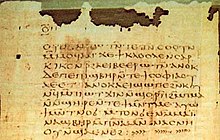Revelation of Peter
The Revelation of Peter or Peter's Apocalypse is an early Christian apocryphal work that was probably written around 135 in Egypt . It represents a literary forgery ( pseudepigraphy ) that pretends to be written by the Apostle Peter .
Time and place of writing
Since the Peter apocalypse probably uses 4th Ezra and 2nd Peter , it was probably written after around 100 AD. It is mentioned in the Muratori canon and used by Theophilus of Antioch and Clement of Alexandria , so it had already found widespread use around 180 AD, so it was probably written a few decades before that at the latest. The attempt to date it more precisely to around 135 or shortly thereafter refers to the fig tree parable in Chap. 2 on the Jew Bar Kochba . This “ revelation ” was probably written down in Alexandria, probably by a Jewish Christian who drew from Jewish and Greek eschatological sources.
Dissemination and recognition
A Greek and an Ethiopian version have survived. The Revelation of Peter was widespread from around 150 AD, especially in the Greek-speaking East, and was valued by some church fathers , but overall it was always controversial. In the Muratori Canon , the Revelation of Peter was recognized, but described as controversial. It was never translated into Latin , which is why it was hardly read in the Latin West from around AD 200, as knowledge of Greek decreased significantly there. It was valued in the East: Clement of Alexandria wrote a comment about it, and it is mentioned at the end of the canons of the Codex Claromontanus . On the other hand, it is not included in Origen's canon , and Eusebius of Caesarea made it one of the bogus books. It still had a strong effect in the Middle Ages .
Scope and content
The Revelation of Peter is a rather small book; it is about half the size of Epistle to Hebrews . The text offers a very detailed description of the future hell and its punishments brought about by Ezrael , which have fed the Christian imagination up to Dante's “Inferno” of the Divine Comedy .
Like many other detailed depictions of the punishments of hell in the High Middle Ages , the depiction of the Last Judgment on a mosaic by Torcello (early 12th century) goes back to the Apocalypse of Peter.
literature
- Caspar Detlef Gustav Müller : Revelation of Peter (introduction and German translation). In: Wilhelm Schneemelcher (Ed.): New Testament Apocrypha in German translation. Volume 2: Apostolic, Apocalypses and related matters. 5th edition. Mohr, Tübingen 1989, ISBN 3-16-145181-3 , pp. 562-578.
- Albrecht Dieterich : Nekyia: Contributions to the explanation of the newly discovered Peter apocalypse. B. G. Teubner, Leipzig 1893, OCLC 44999098 , pp. 1-18 ( Scan - Internet Archive ).
Web links
- The Revelation of Peter ( memento of January 29, 2016 in the Internet Archive ). In: barnabas-evangelium.de (German translation)
Remarks
- ↑ See also the parable of the fig tree without fruit , the parable of the fig tree, and the curse of the fig tree .
- ↑ Eusebius: Church history . III, 25, 4. In the same book, Eusebius also quotes Origen's canon in V, 25.
- ↑ Compared to Franz Stuhlhofer : The Use of the Bible from Jesus to Euseb. A statistical study of the history of the canons (= Theologische Verlagsgemeinschaft [Ed.]: Monographs and Study Books . Volume 335). Preface by Rainer Riesner . R. Brockhaus, Wuppertal 1988, ISBN 3-417-29335-9 , p. 38 f.

